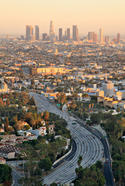The great Central Valley of California has never been an easy place. Dry and almost uninhabitable by nature, the state's engineering marvels brought water down from the north and the high Sierra, turning semi-desert into some of the richest farmland in the world. read more »
Middle Class
Different Shades of Green
Last month marked the 15th anniversary of the settlement of Plotkin vs. General Electric, the landmark “greenwashing” lawsuit I filed in 1993. At the time, GE was misleading consumers by selling phony lookalike energy efficient light bulbs that were in fact just old fashioned incandescent wolves in green packaging.
I took no money from the case. But I required G.E. to make labeling changes and to pony up $3.25 million dollars in consumer refunds and donations to environmental and public service groups. The labeling changes made it easier for the manufacturers of real energy efficient light bulbs, which were just then entering the marketplace, to distinguish their products on the shelves. read more »
How the Financial Crisis Threatens Localism
By Richard Reep
As in many places, the poor economy is forcing many families in affluent Winter Park, Florida to make some necessary adjustments. One of the most basic adjustments relates to shopping for food and staples. In better times, Winter Park was ruled by two Publix supermarkets and a Whole Foods. Grocery-cart conversation among friends became a common event; now this smooth, middle-class lifestyle pattern has been disrupted. read more »
How Houston Will Weather The Recession
In the past year or so, traveling the various geographies of this country has become increasingly depressing. From the baked Sun Belt suburbs to the green Valhallas of Oregon and the once luxurious precincts of Manhattan, it is hard to find much cheer--at least from entrepreneurs--about the prospects for the economy.
Until recently Texas, and particularly Houston, has been one of the last bastions of that great traditional American optimism--and for good reason. Over the past few years, Houston has outperformed every major metropolitan area on virtually every key economic indicator. read more »
- Login to post comments
Sunbelt Indianapolis
For decades, the overwhelming majority of population and economic growth has occurred in the Sun Belt – the nation’s South and West as defined by the United States Bureau of the Census. This broadly-defined area stretches south from the Washington-Baltimore area to the entire West, including anything but sunny Seattle and Portland. Any list of population growth or employment growth among the major metropolitan areas will tend to show the Sun Belt metropolitan areas bunched at the top and the Frost Belt areas (the Northeast and Midwest regions) bunched at the bottom. read more »
Urban Inequality Could Get Worse
President Obama's stated objective to reduce inequality, as laid out in public addresses and budget plans, is a noble one. The growing income gap – not only between rich and poor, but also between the ultra-affluent and the middle class – poses a threat both to the economy and the long-term viability of our republic.
But ironically, what seems to be the administration's core proposal, ratcheting up the burden on "rich" taxpayers earning over $250,000, could have unintended consequences. For one thing, it would place undue stress on the very places that have been Obama's strongest supports, while providing an unintended boost to those regions that most oppose him. read more »
The Aging of Paradise in Ventura County California
You could say that Ventura County, just north of Los Angeles, represents what is best about California. Some people believe that its amenities – beaches, gorgeous interior valleys and parks – assure perpetual economic growth for Ventura County and California. They are wrong. There is trouble in paradise.
Ventura County has changed, and not for the better. It is aging, losing its demographic as well as economic vitality. This represents a relatively new phenomenon, the slow decline of even formerly healthy suburban areas. read more »
- Login to post comments
Democrats Could Face an Internal Civil War as Gentry and Populist Factions Square Off
This is the Democratic Party's moment, its power now greater than any time since the mid-1960s. But do not expect smooth sailing. The party is a fractious group divided by competing interests, factions and constituencies that could explode into a civil war, especially when it comes to energy and the environment.
Broadly speaking, there is a long-standing conflict inside the Democratic Party between gentry liberals and populists. This division is not the same as in the 1960s, when the major conflicts revolved around culture and race as well as on foreign policy. Today the emerging fault-lines follow mostly regional, geographical and, most importantly, class differences. read more »
The Decline of Los Angeles
Next week, Antonio Villaraigosa will be overwhelmingly re-elected mayor of Los Angeles. Do not, however, take the size of his margin – he faces no significant opposition – as evidence that all is well in the city of angels.
Whatever His Honor says to the media, the sad reality remains that Los Angeles has fallen into a serious secular decline. This constitutes one of the most rapid – and largely unnecessary – municipal reversals in fortune in American urban history. read more »
What Does “Age of Hope” Mean in the Mississippi Delta?
It was during the inaugural days that an article appeared in The Washington Post about the predominantly black Mississippi Delta going for Obama – no surprise! But juxtaposed in the same time period there appeared in a Kentucky newspaper the story of predominantly white Menifee County, my birthplace – deep in the heart of Appalachia – defying the red sea of Kentucky all around it and also going for Obama. read more »






















